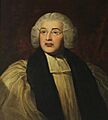George Horne (bishop) facts for kids
Quick facts for kids The Right Reverend George Horne |
|
|---|---|
| Bishop of Norwich | |
 |
|
| Diocese | Diocese of Norwich |
| In Office | 1790–1792 |
| Predecessor | Lewis Bagot |
| Successor | Charles Manners-Sutton |
| Other posts | Dean of Canterbury (1781–1790) |
| Personal details | |
| Born | 1 November 1730 Otham, Kent |
| Died | 17 January 1792 (aged 61) Bath, Somerset |
| Buried | Eltham Church |
| Nationality | British |
| Denomination | Anglican |
| Education | Maidstone Grammar School |
| Alma mater | University College, Oxford |
George Horne (born November 1, 1730 – died January 17, 1792) was an important English church leader, a university professor, and a writer. He held several high positions, including Bishop of Norwich.
Contents
Early Life and Education
George Horne was born in a village called Otham in Kent, England. His father, Samuel Horne, was a church rector. George went to Maidstone Grammar School with his cousin, William Stevens, who became a lifelong friend.
In 1746, George went to University College, Oxford. He earned his first degree in 1749 and continued his studies. While at Oxford, he became good friends with three other students who later became important figures themselves.
A Leader at Oxford University
In 1749, George Horne became a Fellow at Magdalen College, Oxford. This meant he was a senior member of the college. He was later elected as the President of the college in 1768.
As President, he was a very important leader. From 1776 to 1780, he also served as the Vice-Chancellor of the University of Oxford. This role meant he was in charge of running the entire university. During this time, he worked hard to keep the rule that students had to agree with the beliefs of the Church of England to join the university.
Church Career
George Horne became a priest in 1753. For a few years, he worked as a curate in a village called Horspath. After that, he mostly carried out his church duties at Magdalen College.
In 1771, he was chosen to be a chaplain in ordinary to King George III. This meant he was a special priest who served the King. He held this position until 1781.
Later, in 1781, he became the Dean of Canterbury. This was a very important role in the church. He was a busy dean and helped start Sunday schools to teach young people. He also supported the Naval and Military Bible Society, which gave Christian books to soldiers and sailors.
In 1790, even though he was not well, he accepted the job of Bishop of Norwich. This was a very high position in the church. He had to leave his role as Dean of Canterbury and later from Magdalen College. As Bishop, he supported the bishops of the Episcopalian Church of Scotland. They were asking the government for more rights. He believed that "true religion and true learning were never yet at variance," meaning they always went together.
Ideas and Beliefs
George Horne was a strong supporter of the high church part of Anglicanism. This meant he believed in traditional church practices and teachings. He often wrote and preached to defend the Church of England against other groups. He was known as a great preacher, and his sermons were printed many times.
He was influenced by the ideas of John Hutchinson. He also had friends like Samuel Johnson, a famous writer. They even discussed making a new edition of a book called Lives by Izaak Walton. Horne enjoyed reading Edward Gibbon's work but disliked how Gibbon often criticized Jewish and Christian traditions.
Horne believed strongly in revealed religion, which means beliefs that come from divine messages, rather than natural religion, which relies on human reason. His ideas helped connect older church traditions with new movements in the 1800s.
Writings
George Horne wrote many books and pamphlets. Here are some of his important works:
- The Theology and Philosophy of Cicero's Somnium Scipionis (1751): This was a funny pamphlet.
- A Fair, Candid, and Impartial Statement of the Case between Sir Isaac Newton and Mr. Hutchinson (1753): He wrote this anonymously.
- Commentary on the Psalms (1771): This is his most famous work. It explains the Psalms in the Bible, showing how many of them relate to Jesus. Many people admired this book.
- A Letter to Dr. Adam Smith (1777): This was also anonymous. It argued against Adam Smith's views on David Hume and defended Christian beliefs.
His collected Works were published after he died, along with a story about his life written by William Jones.
Family Life
In 1768, George Horne married Felicia Elizabetha Burton. They had three daughters:
- Felicia Elizabetha (born 1770)
- Maria (born 1773)
- Sarah (born 1775)
Sarah was taught by Hannah More, another friend of George Horne.
George Horne passed away in Bath, Somerset on January 17, 1792, when he was 62 years old. He was buried in Eltham.
Images for kids


